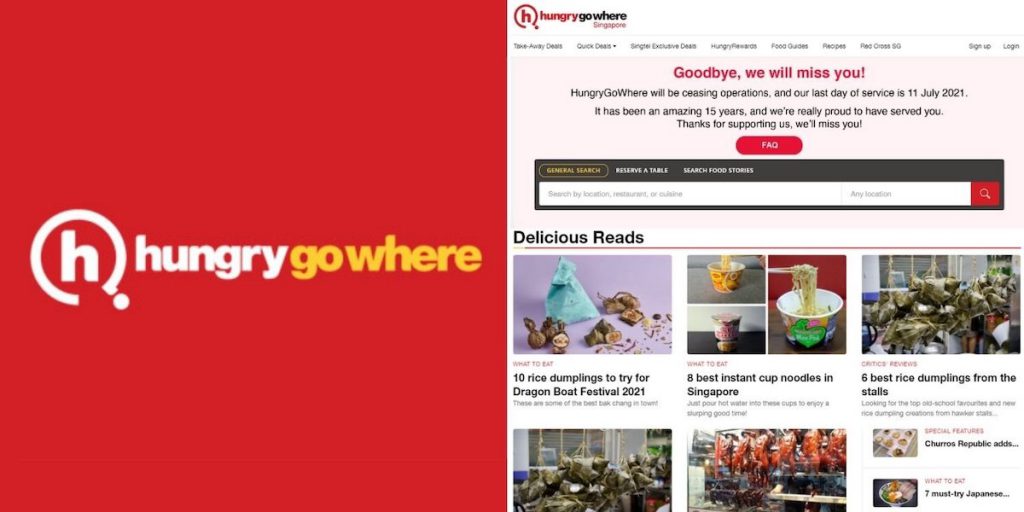It sold for S$12 million to Singtel in 2012.
Fast forward nine years later, this online reviews food guide — which once had over 16,000 listings on its site — is having its last meal next month.
What exactly went down for this online business that was once valued at millions of dollars?
In 2018, the firm’s revenue was hitting US$3.21 million. That’s over a 13 per cent increase compared to the previous year, according to startup and private firm tracker Tracxn Technologies.
Responding to media queries, Singtel had explained that HungryGoWhere’s closure was a result of the “severe challenges” in the industry.
The decision is in line with the group’s attempt to refocus its business, adding that it had conducted a detailed review of HungryGoWhere and explored various options for the business.
“It has faced severe challenges posed by competitive pressure in the industry, which has been exacerbated by the Covid-19 pandemic. As a result, we have decided to exit the restaurant reservations market,” said the telco.
It was once the “leading food portal in Singapore”
HungryGoWhere was founded by three entrepreneurs — Dennis Goh, Tan Yung Yih and Wong Hoong An — in 2006.
In 2012, HungryGoWhere’s parent company GTW Holdings was acquired for S$12 million by Singtel. The restaurant review portal was then touted the “leading food portal in Singapore”.

Singtel had then aimed to “re-shape” culinary experiences across Asia. The plan was to merge with lifestyle and local search site inSing.com to create the largest food and lifestyle go-to site.
The group had said in 2012 that eating out was a top ranking activity among consumers in Singapore, with a large percentage of online search queries restaurant-related.
Six years later in 2018, a Nielsen survey which polled over 200 people showed that one in four eat out daily, improving from one in five in 2015.
That same year, HungryGoWhere was hitting an annual revenue of around US$3 million, according to data from Tracxn Technologies.
Then came Covid-19 in 2020, which threw things into disarray.
Nishant Kaushal, creative intelligence agency ADNA’s head of data, strategy and solutions says that as a service, HungryGoWhere.com was unable to adapt fast enough to the changing food industry, and the Covid-19 changes didn’t make the situation any easier.
According to ADNA, the pandemic had led to more Singaporeans eating at home last year. If that wasn’t enough, one in four people found it a hassle to eat out due to pandemic-related dining in restrictions.
It further cited that 33 per cent of Singaporeans don’t plan to eat out at restaurants as often in the future.
How are other players coping with Covid-19 challenges?
A survey of 63 Singapore restaurants and food businesses which was conducted this year found that food orders have plunged up to 85 per cent on-year.
According to ADNA, in the month of May, the search volume of “eating out” sank 88 per cent versus the same period in the year 2006. The search results are also just as bad for online search for “restaurant reviews”.
Most of HungryGoWhere’s competitors are aggressively adapting to change and finding ways to deal with the new realities of Covid-19 to hold the fort.

Eatigo, which boasts over 4,000 restaurants on its platform, has expanded to offer delivery or pick-up services in the first quarter of this year. The firm is currently working with delivery firms like Lalamove and Grab Express to send food to its customers.
Chope has moved into that space too. It says it had pivoted once circuit breaker hit the Republic last year.
Another platform, Burpple, has since launched a takeaway service. It runs promotions like one-for-one deals to attract customers.
Quandoo meanwhile, is not looking into delivery services. The platform, which claims to have 17,000 restaurants worldwide has other revenue streams, like its personalised restaurant technology and digital marketing services.
Win over the big boys

Even as these restaurant booking platforms adapt to food delivery and takeaways to survive, they are still moving into an already crowded industry. Food delivery titans like GrabFood, Foodpanda and Deliveroo are taking up most of the food delivery pie.
According to analytics platform Statista, 77 per cent of Singaporeans used GrabFood for food delivery orders last year, followed by Foodpanda and Deliveroo.
So how can these “new players” build a competitive edge over the big boys? These platforms will have to come up with strategies that are unique to them.
One way to compete would be to provide attractive booking rates for restaurants. Leveraging on the existing relationship these platforms have with restaurants, they can arrange for exclusive deals and attractive offers to keep customers coming.
These platforms may also consider featuring eateries with the SG Clean certification. Keeping to high cleaning standards will attract patrons who want to eat out safely without concerns on hygiene.
Family-owned Da Paolo Group, for example, has that certification in its restaurants. It performs stringent cleanliness checks like sanitising tables after every use and keeping to safe distancing. Its staff are kept in the loop with a safety management system uploaded on the cloud.
In a post-pandemic era, it’s the least food-related businesses can do to assure customers and give them a peace of mind.
Featured Image Credit: HungryGoWhere











